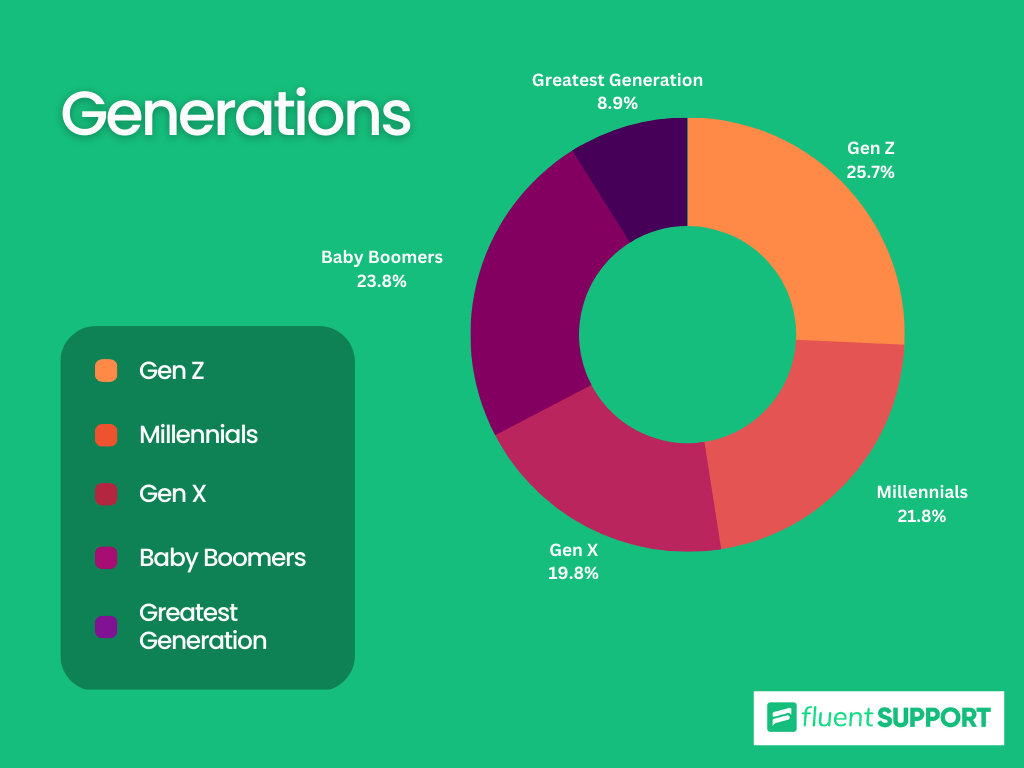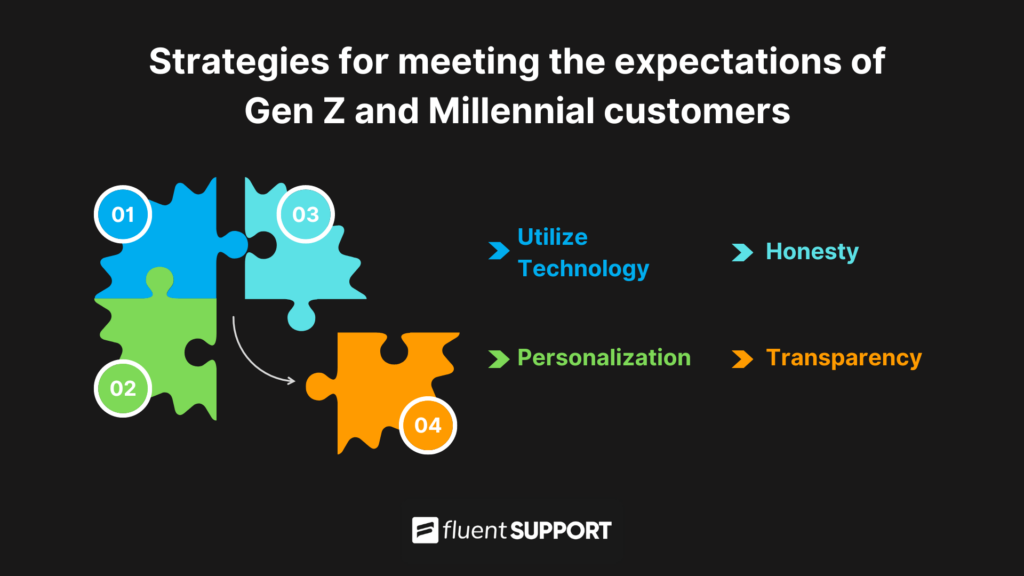
Gen Z vs Millennials – Differences in Their Customer Service Expectations
Providing exceptional customer service is a must for businesses of all sizes. With Gen Z and Millennials making up a significant portion of the consumer market, it is important to understand their unique needs and preferences in terms of customer service.
Here, we will explain the key differences between the customer service for Gen Z and Millennials, and explore strategies for meeting the expectations of both groups. Also, we’ll take a look at the latest trends and best practices for delivering an outstanding service experience for Gen Z and Millennials.
Understanding the basic differences – Gen Z vs Millennial customers
As the customer base evolves, so do the expectations and preferences of the consumers. Gen Z and Millennials are two distinct groups with their own unique needs.

Generation Z aka Gen Z (1997-2012)
Generation Z or Gen Z, also known as the post-millennial generation, is defined as those born between 1997 and 2012. They are the first true digital natives and have grown up with technology at their fingertips.
Gen Zers have high expectations for fast and efficient service and appreciate personalized experiences. They are also more likely to research products and services online before making a purchase. Besides, they tend to rely on social media and online reviews to inform their decisions.
When it comes to buying practices, this generation is heavily influenced by
- Their peers
- Trending social media content
- Perceived ethical considerations
For Gen Z, purchasing is seen as an expression of identity, with ethical concerns taking priority in their decision-making processes.
Millennials (1981-1996)
Millennials are defined as those born between 1981 and 1996. They also grew up with technology and have a strong preference for self-service options. For example, online chat and FAQs.
Also, they value personalization but are more likely to reach out for human assistance when needed.
There are a lot of underdeveloped or previously underdeveloped countries where millennials did not have much access to technology in their early childhood or when they were teens.
So, though they’re millennials, but regions that fall into that category didn’t reap many benefits from the actual technological revolution of that era. But in the past 15-20 years, almost every person can access the internet and technology.
Therefore, millennials got comfortable with digital communication and now they prefer self-service models over in-person interactions. Moreover, they are discerning consumers, focused on experiences and quality over cost.
Meeting the expectations of Gen Z and Millennial customers
Let’s take a look at strategies for meeting their expectations.

- Firstly, businesses need to utilize technology to provide fast and efficient service. Technology includes using chatbots, AI-powered virtual assistants, etc. to handle routine requests and inquiries. Also, implementing self-service options such as online chat and FAQs.
- Personalization is also key when it comes to the customer service experience. Gen Z and Millennials appreciate when businesses take the time to understand their unique needs and preferences. This can be achieved through the use of customer data and analytics, as well as by offering personalized recommendations and promotions.
- Another key strategy is to provide honesty and transparency. Gen Z and Millennials are more likely to trust companies that are open and transparent about their policies and practices. This includes giving clear and accurate information on products and services, as well as being responsive and accountable when things go wrong.
Best practices for delivering an exceptional customer service experience
In order to deliver exceptional customer service for Gen Z and Millennials, businesses need to adopt a holistic approach. An approach that takes into account the unique needs and preferences of these groups.
- One best practice is to use an omnichannel support approach, providing customers with the option to reach out via phone, email, chat, or social media. This allows customers to choose the method that is most convenient for them and ensures that their needs are met on time.
- Train customer support staff to be empathetic and understanding. Oftentimes less empathy creates a bad customer experience. This includes providing them with the tools and resources they need to handle customer inquiries and complaints, as well as encouraging them to take a personalized approach to their interactions with customers.
- Businesses need to be proactive in seeking feedback from their customers. This includes conducting surveys and focus groups, as well as monitoring online reviews and social media posts. Use customer feedback forms to collect feedback from customers regularly. By gathering feedback, businesses can identify areas of improvement and make the necessary changes to enhance the customer service experience.
Role of social media in customer service for Gen Z and Millennials
Social media plays a significant role in the customer service experience for both Gen Z and Millennials. They are more likely to turn to social media to voice complaints or seek assistance, and they expect a fast response.
Businesses need to be active on social media and have a dedicated team in place to monitor. Also, respond to customer inquiries and complaints.
It is also important to note that social media can be used as a tool for customer engagement and building brand loyalty. By creating engaging content and promoting special offers and promotions, businesses can attract and retain the attention of Gen Z and Millennial customers.
Social network user age group demographics
| 13-17 | 18-25 | 26-34 | 35-44 | 45-54 | 55+ | |
| 11% | 29% | 23% | 18% | 12% | 7% | |
| 4% | 13% | 30% | 27% | 17% | 9% | |
| Google+ | 9% | 23% | 35% | 15% | 11% | 7% |
| 0% | 18.1% | 31.2% | 24.8% | 15% | 10.5% | |
| 3% | 6% | 28% | 28% | 25% | 11% |
Impact of COVID-19 on customer service for Gen Z and Millennials
The COVID-19 pandemic has had a significant impact on customer service for Gen Z and Millennials. With many businesses closed or operating at reduced capacity, customers have had to rely more on digital channels for customer service.
Which has led to an increase in demand for chatbots, AI-powered virtual assistants, and self-service options.
Moreover, the pandemic has led to an increase in anxiety and stress among customers, and businesses need to be aware of this and take appropriate measures.
Future of customer service for Gen Z and Millennials
As technology continues to evolve, so too will the customer service experience for Gen Z and Millennials. Businesses need to stay on top of the latest trends and technologies to meet the expectations of these groups.
- A trend to watch is the increased use of virtual reality and augmented reality in customer service. These technologies have the potential to provide immersive and personalized experiences for customers. Businesses that adopt them will have a competitive advantage.
- Increase the use of voice assistants like Amazon Alexa and Google Home. This technology makes it easier for customers to access customer service and can provide more efficient service.
- Offering an exceptional customer service experience for Gen Z and Millennials requires a deep understanding of their unique needs and preferences. Also, it needs a willingness to adopt new technologies and strategies.
Importance of empathy and understanding in customer service for Gen Z and Millennials
Empathy and understanding are critical components of customer service for Gen Z and Millennials. These groups appreciate when support staff shows empathy, and businesses take the time to understand their unique needs or preferences.
- One way to show empathy and understanding is to actively listen to customers and acknowledge their concerns. This can be done through the use of active listening techniques such as repeating what the customer has said and asking open-ended questions.
- Give customer support staff the right tools and resources they need to handle customer inquiries and complaints. This can include providing training on customer service best practices, as well as providing access to relevant customer data and analytics.
- Lastly, businesses should encourage customer support staff to take a personalized approach to their interactions with customers. This includes using the customer’s name, remembering their previous interactions, and making recommendations based on their previous purchases or interests.
Wrapping up
Finally, to give exceptional customer support for both Gen Z and Millennials requires a well-rounded approach that balances technology and human interaction.
Businesses must understand the unique needs and preferences of these generations. Also, we need to be willing to adopt new technologies and strategies to meet the expectations of all types of customers.
To provide the best customer experience, businesses must leverage technology while also prioritizing human interaction. Offering 24/7 chatbots is acceptable, but it is important to ensure that customers have access to real, live human agents if they encounter problems.
Furthermore, businesses should strive to personalize the experience, be transparent and honest, provide multi-channel support, and show empathy and understanding.
Thank you for reading. Stay tuned with Fluent Support for more useful blogs like this.












Leave a Reply